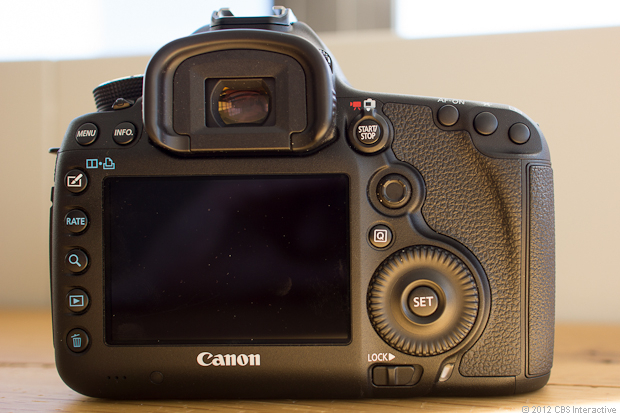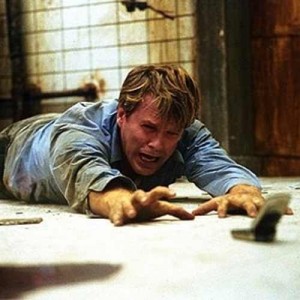On the 25th anniversary of its EOS system, Canon finally announces the long-awaited update to its full-frame 5D Mark II dSLR. It’s packed with capabilities for both still and video shooters, but at a much steeper price.
 I’ve found that photographers fall into two camps: those who use their camera till it drops dead of exhaustion before considering a new model, and those who feel the need to update as often as possible. I think the wait for the Canon EOS 5D Mark III has been killing both those groups. It’s been so long that a lot of hard-used 3-plus-year-old 5D Mark IIs are ready to surrender, and the frequent updaters have been buffeted on a sea of rumors and delays. But the 5DM3 is almost here–shipping within a few weeks, in theory–and it looks like it will have what it takes to please them both.
I’ve found that photographers fall into two camps: those who use their camera till it drops dead of exhaustion before considering a new model, and those who feel the need to update as often as possible. I think the wait for the Canon EOS 5D Mark III has been killing both those groups. It’s been so long that a lot of hard-used 3-plus-year-old 5D Mark IIs are ready to surrender, and the frequent updaters have been buffeted on a sea of rumors and delays. But the 5DM3 is almost here–shipping within a few weeks, in theory–and it looks like it will have what it takes to please them both.
While the 5DM3 is obviously big news, Canon’s intent to drop of the price of the 5DM2 (to what, I don’t know yet) and keep it on the market is pretty important, too: $3,500 is pretty steep for a lot of people who want to go full-frame, and it helps keeps Canon in competition with the newly price-reduced Nikon D700.
As you’d expect, the 5DM3 consists of a combination of technologies, features, and design updates rolled out in the EOS 7D and the more recent 1D X. The result is a camera that looks similar to its predecessor but that’s otherwise almost completely different.
Though a different sensor than that of the 1D X, it uses a lot of the same technology that Canon rolled out for that model, including gapless microlenses and improved quantum efficiency (to improve the amount of light capturable on the photodiodes); better on-chip noise reduction; and faster data readout (dual four-channel readouts). Though it has 6.25-micron sites compared with 6.4 microns on the older sensor, Canon claims that all the other advances, including the better processing in the Digic 5+ engine, delivers overall better noise performance–2 stops better for JPEG and video. Canon does say the 1D X remains about one stop cleaner, however.
The camera also inherits the sophisticated 61-point reticulated autofocus system from the 1D X, along with the ability to customize the AF-point groupings. It uses the older metering system from the 7D, however, which theoretically shouldn’t matter here: the newer system enables features like face and object tracking to boost burst-shooting autofocus performance, but this camera really isn’t for the serious continuous shooters.
Incorporating Digic 5+ adds a lot of important features. These include support for UDMA 7 CF; the camera now has dual CF/SDXC card slots, which is a really useful feature. And Canon implements it with the novel ability to configure it to record different sizes/quality of raw or JPEG files saved to each card. There’s also three-shot in-camera HDR, but you can save the source images as well as add some effects. (For manual HDR, you get a bump to seven-frame bracketing at +/-5 EV.) Additionally, it offers the same powerful multiple-exposure mode as the 1D X.
The Digic 5+ also adds the new video encoders (All-I and IP-B) which appeared in the 1D X, along with 720/60p recording and improved moire handling. The 5DM3 also gets a headphone jack, time code support, and 64 levels of audio control plus a wind filter. One video disappointment: the camera only outputs the display view via HDMI, so you can’t get high-resolution video capture that way and it has the display overlay. On the other hand, you’re no longer limited to 12-minute clips.
Interestingly, although it has a new shutter mechanism with bounce-dampening technology to decrease noise and vibration as in the 1D X, the shutter’s durability doesn’t seem to have been improved. Though Canon cited improved shutter speed (from 75ms in the 5DM2 down to 59ms, which is close to but not as fast as the 1D X at 55ms), and the boost in burst speed to 6fps, no mention was made about overall performance. With a faster AF system and faster cards you’d expect better shooting speed, but the increase in resolution sometimes makes it a wash.
There are some usability enhancements as well. My favorite: the viewfinder, though the same size and magnification, now covers 100 percent of the scene, and the spot meter has been reduced to 1.5 percent of the frame. The viewfinder also has an optional grid overlay and can supply alerts for a handful of settings that affect picture quality, such as ISO expansions.
While Canon has improved the dust-and-weather sealing through some increased gasketing and a better-constructed magnesium alloy chassis (with stainless-steel lens mount), it still doesn’t sound as rugged as you’d expect for the money; you might say that its large base of wedding shooters may not need that, but a camera gets around a lot more than it used to, especially in the hands of videographers. That said, most of the updates to the body are quite welcome, including a locking mode dial (albeit with the annoying center button from the 60D); touch pad on the control dial for silent adjustments during movie shooting; and a 7D-like control for Live View and Movies. In addition to a comparison playback view, there’s a dedicated button for rating photos. The menu system is just like that of the 1D X, extremely broad and deep, with tons of options, like the extreme customizability of the AF system and AF tracking sensitivity.
Here’s where it fits in the competitive landscape:
|
Canon EOS 5D Mark II |
Canon EOS 5D Mark III |
Canon EOS 1D X |
Nikon D700 |
Nikon D800/ D800E |
|
| Sensor (effective resolution) | 21.1-megapixel CMOS 4-channel readout 14 bit |
22.3-megapixel CMOS 8-channel readout 14-bit |
18-megapixel CMOS 2-line, 16-channel readout 14-bit |
12.1-megapixel CMOS n/a 14 bit |
36.3-megapixel CMOS n/a 14 bit |
| 36 mm x 24mm | 36 mm x 24mm | 36 mm x 24mm | 36 mm x 23.9mm | 35.9 mm x 24mm | |
| Focal-length multiplier | 1.0x | 1.0x | 1.0x | 1.0x | 1.0x |
| Sensitivity range | ISO 50 (exp)/100 – ISO 6400/25600 (exp) | ISO 50 (exp)/100 – ISO 25600/102,400 (exp) | ISO 50 (exp)/ 100 – ISO 51,200/204,800 (exp) | ISO 100 (exp)/200 – ISO 6400/ 25,600 (exp) | ISO 50 (exp)/100 – ISO 6400/ 25600 (exp) |
| Continuous shooting | 3.9fps 14 raw/310 JPEG |
6fps n/a |
12fps n/a |
5fps 17 raw/100 JPEG |
4fps n/a (5fps with battery grip) |
| Viewfinder magnification/ effective magnification |
100% coverage 0.71x/0.71x |
100% coverage 0.71x/0.71x |
100% coverage 0.76x/0.76x |
95% coverage 0.72x/0.72x |
100% coverage 0.70x/0.70x |
| Autofocus | 9-pt AF 1 cross type |
61-pt High Density Reticular AF 21 center diagonal to f5.6 5 center to f2.8 20 outer to f4 |
61-pt High Density Reticular AF 21 center diagonal to f5.6 5 center to f2.8 20 outer to f4 |
51-pt 15 cross type |
51-pt 15 cross type; 11 cross type to f8 |
| AF exposure range | -0.5 – 18 EV |
-2 – 20 EV | -2 – 20 EV | -1 – 19 EV | -2 – 19 EV |
| Shutter speed | 1/8,000 to 30 secs; bulb; 1/200 sec x-syn | n/a | 1/8,000 to 30 secs; bulb; 1/250 sec x-sync (est) | 1/8,000 to 30 secs; bulb; 1/250 sec x-sync | 1/8,000 to 30 secs; bulb; 1/250 sec x-sync |
| Shutter durability | 150,000 cycles | 150,000 cycles | 400,000 cycles | 150,000 cycles | 200,000 cycles |
| Metering | 35-zone TTL | 63-area iFCL | 252-zone RGB | 1,005-pixel RGB sensor 3D Color Matrix Metering II | 91,000-pixel RGB 3D Color Matrix Metering III |
| Metering exposure range | 1 – 20 EV | 0 – 20 EV (est) | 0 – 20 EV | 0 – 20 EV | 0 – 20 EV |
| Image stabilization | Optical | Optical | Optical | Optical | Optical |
| Video | H.264 QuickTime MOV 1080/30p/ 25p/24p; 720/25p/24p | H.264 QuickTime MOV 1080/30p/25p/24p; 720/60p/50p |
H.264 QuickTime MOV 1080/30p/25p/24p; 720/60p/50p |
None | H.264 QuickTime MOV 1080/30p/ 25p/24p; 720/60p/50p/ 25p/24p |
| Rated estimated max HD video length at best quality | 4GB (approx 12 minutes) |
29m59s | 4GB (29m59s) |
n/a | 20 minutes |
| Audio | mono; mic input | mono; mic input; headphone jack | mono; mic input; headphone jack | n/a | mono; mic input; headphone jack |
| LCD size | 3 inches fixed 920,000 dots |
3.2 inches fixed 1.04 megadot |
3.2 inches fixed 1.04 megadot |
3 inches fixed 921,000 dots |
3.2 inches 921,000 dots |
| Memory slots | 1 x CF (UDMA mode 7) | 1 x CF (UDMA mode 7), 1 x SDXC | 2 x CF (UMDA mode 7) | 1 x CF (UDMA mode 6) | 1 x CF (UDMA mode 7), 1 x SDXC |
| Wireless flash | No | No | No | Yes | Yes |
| Battery life (CIPA rating) | 850 shots (1,800mAh) |
n/a (1,800mAh) |
n/a (2,450mAh) |
1,000 shots (1,500mAh) |
850 shots (1,800mAh) |
| Dimensions (inches, WHD) | 6.0 x 4.5 x 3.0 | n/a | 6.4 x 6.2 x 3.3 | 5.8 x 4.8 x 3.0 | 5.7 x 4.8 x 3.2 |
| Body operating weight (ounces) | 32.9 | n/a | n/a | 38.7 | 31.7 (est) |
| Mfr. price | $2,499 (body only) | $3,499 (body only) | $6,800 (body only) | $2,199.95 (body only) | $2,999.95/ $3,299.95 (body only) |
| n/a | $4,299 (with 24-105mm lens) | n/a | n/a | n/a | |
| Ship date | November 2008 | March 2012 | April 2012 | July 2008 | March 2012/ April 2012 |
 All these improvements make the 5DM3 seem like an incredibly attractive camera, with enough there to merit upgrade consideration for 5DM2 pros who can justify the not-inconsiderable expense. If you’re price-sensitive, the D800 obviously looks better, but you’ve got to be a real rez-head to consider the D800’s pixel count a serious advantage and that presumes you’re not committed to a system already.
All these improvements make the 5DM3 seem like an incredibly attractive camera, with enough there to merit upgrade consideration for 5DM2 pros who can justify the not-inconsiderable expense. If you’re price-sensitive, the D800 obviously looks better, but you’ve got to be a real rez-head to consider the D800’s pixel count a serious advantage and that presumes you’re not committed to a system already.
Along with the 5DM3, Canon simultaneously announced some new accessories targeted at the same class of photographer.
Speedlite 600EX-RT ($629.99, March): This replaces the 580EXII at the top of Canon’s flash offerings, finally incorporating wireless flash mastery. It supports radio or line-of-sight and five groups of flashes on 16 channels.
Speedlite Transmitter ST-E3-RT ($470, March): This is essentially the 600EX-RT without the flash.
Battery Grip BG-E11 ($490, April): Though the 5DM3 takes the same batteries as the 5DM2, the grip’s been updated with a duplicated multicontroller.
Wireless Transmitter WFT-E7A ($849, April): This adds a lot of the wireless and wired Ethernet capabilities that come built-in to the 1D X, including time syncing, FTP, EOS Utility mode, WFT Server, and Media Server capabilities.
GPS GP-EP2 ($390, April): A hot-shoe-based GPS receiver that supports GPS logging.
Author : Lori Grunin, Senior Editor Lori Grunin has been covering digital imaging and all types of tech for two decades and photographing for four, but the stat she’s proudest of is the approximately 5,000 photos she’s taken of cats (and some dogs) for the animal rescue where she volunteers.




































